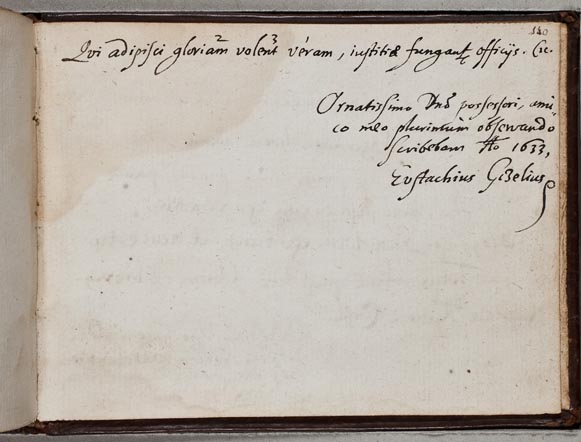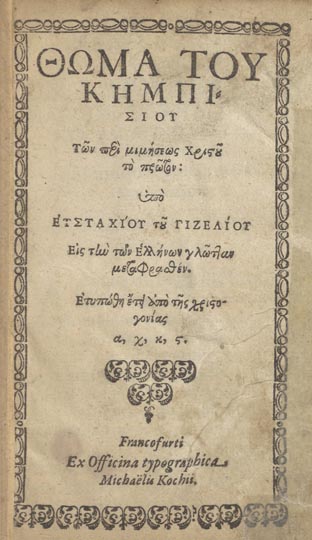Gizel, Yevstakhii
Gizel, Yevstakhii or Eustachius [Ґізель, Євстахій; Gizel', Jеvstaxij], b ca. 1600 probably in Vilnius, d 1655 probably in Volhynia. Writer, churchman, poet, polemicist, and Socinian religious leader; brother of Innokentii Gizel. Born into a Ruthenian Orthodox family, Yevstakhii Gizel was the son of Fedir Gizel (Kgezel), a member of the Vilnius Orthodox Brotherhood of the Holy Spirit and a priest in the Church of the Holy Spirit in Vilnius. From 1621 Gizel studied at the Zamostia Academy. In 1625 his benefactor Rafał Leszczyński (Rafail Leshchynsky), the voivode of Belz and a patron of Calvinists, sent Gizel, together with Heorhii Smotrytsky (the son of Stefan Smotrytsky and nephew of Meletii Smotrytsky), to study at the Schönaichianum-Carolatheum Academy in Beuthen-on-Oder (present-day Bytom in Poland). It is likely that Gizel developed his Unitarian sympathies during his time at the Schönaichianum that was famous for its Protestant professors and Socinian students, such as the later famous historian and preacher Andrzej Węgierski.
While at the Schönaichianum, Gizel translated from Latin into Greek Των περὶ μιμήσεως Χριϛοũ τὸ πρωτον, the first book of The Imitation of Christ by Thomas à Kempis. This translation, today known in two attested copies, was published in 1626 in Frankfurt-on-Oder. In this bilingual edition, the Latin text was taken from the 1620 edition, tracing back to the 1563 Sebastian Castellio’s ‘translation from Latin into Latin.’ Castellio’s text was likely chosen because his ‘edits’ were in line with the Reformed Church’s reading of the Imitation and thus could please Gizel’s patron Rafał Leszczyński, the addressee of the book’s preface. Gizel’s own Greek translation was based on an autograph of Thomas à Kempis. This translation was apparently intended to showcase Gizel’s mastery of Greek to his patron and revealed Gizel’s departure from Orthodoxy.
During his studies, Gizel established himself as a poet, proficient in Greek. Gizel likely spent some time in his patron’s estate in Leszno, where he met several Protestant intellectuals, including songwriter and poet laureate Michael Aschenborn who later became rector of the Leszno gymnasium. In 1627 Aschenborn published a collection of funeral poems in honor of the deceased Jan Potocki, starosta of Tovmach; this collection included Gizel’s Greek language epigram. We find Gizel’s another Greek epigram among the encomia in Ephorus Nobilis et Orthodoxus (A Noble and Orthodox Guardian, 1628), an early work of a renowned physician and naturalist John Johnston (1603–75), who was also an alumnus of the Schönaichianum and who resided in Leszno in 1625–28.
In 1628 Gizel moved to Kyiv, where, for a short time, he served as rector of the Orthodox Kyiv Epiphany Brotherhood School. Mostly likely, under the guise of an Orthodox official, Gizel continued to adhere to his pro-Socinian views until they were exposed and this led to his dismissal. In 1632 he published his main work of polemical literature: Antapologia—a 628-page polemical treatise directed against Meletii Smotrytsky’s Apologia peregrinatiey do kraiów wschodnych (Apology for the Peregrination to Eastern Lands, 1628), a work in which Smotrytsky for the first time publicly expressed his pro-Uniate views, following his conversion. Gizel’s Antapologia was dedicated to Metropolitan Petro Mohyla and was evidently written with the intent of regaining Mohyla’s trust. Gizel attempted to demonstrate his adherence to the Orthodox faith through his detailed denunciations of Smotrytsky’s religious views that had led to the latter’s apostasy. Gizel’s opus magnum was published under a pseudonym ‘Gelasius Diplic’ (Double Mocker) and without naming the place of publication. In actuality, the book was published by the Socinian printing press of Sebastian Sternacki in the Socinians’ centre of Raków, where Gizel may have studied. Gizel’s attacks on Smotrytsky in his Antapologia reveal his own double-edged argumentative agenda. Inasmuch as Smotrytsky was a covert Uniate in an Orthodox milieu, Gizel was a covert Socinian in an Orthodox milieu. Thus, Gizel’s polemical work was directed not against Smotrytsky’s conversion per se from the Orthodoxy to the Greek Catholic church, but against Smotrytsky’s move in the direction of Catholicism. By condemning Smotrytsky, Gizel tried to subvert both the Catholic authority (by describing their dubious gain of an apostate) and the Orthodox hierarchy (that for a long time kept Smotrytsky in its ranks). Gizel’s argumentation strategy in Antapologia was based on criticizing Smotrytsky’s ideas from a point of view that could be at least partially shared by the Orthodox and the Socinians. His choice of a genre of antapologia (likely inspired by his Socinian mentor Jonasz Szlichtyng’s work Na Antapologią ks. Daniela Clementiusa o potwarzach odpowiedź [A Response to Rev Daniel Clementius’s Antapologia about Slanders; Raków, 1631]), allowed him to refrain from expressing explicitly his own personal views, which was helpful for a Socinian who tried to convince the metropolitan of Kyiv that he was Orthodox. Gizel’s double subversion (directed both against Catholicism and the Orthodoxy) and his close association with the Protestant movement was also noticeable in the preface to Antapologia, where he revendicated those authors who had been refuted by Smotrytsky, including Khrystofor Filalet (likely a pseudonym of a Protestant polemicist Marcin Broniewski). However, Gizel’s attempts did not achieve the intended results. In December 1634 Petro Mohyla, in a gesture indicating his favour for the Union, wrote a letter to Prince Adam Oleksander Sanguszko stating that all of the copies of Antapologia located in the Myltsi Monastery in Volhynia would be publicly burned.
Subsequently, Gizel openly exhibited his association with the Protestant movement. In 1633 he likely moved to Cracow in order to pursue further studies at the Cracow Academy and established relations with Johannes Naeranus, or Jan van der Neer (1608–79), a Remonstrant minister and book publisher supporting Сalvinists and Socinians in the Polish-Lithuanian Commonwealth. Also, together with Piotr Stojeński and Jonasz Szlichtyng, he worked on the translation of the New Testament in 1635. In 1634–38 Gizel served as principal of the Socianian school in Kyselyn (Kysylyn) in Volhynia. At the Kyselyn council of 1640 he was accused of upholding excessively provocative and scandalous views and of using forbidden books. He was excommunicated, but, presumably, he later recanted his ideas for the sake of being reunited with the Socinian community.
Little is known about his later life. In the late 1640s and 1650 Gizel resided as ‘regent’ in Kremenets, where he chronicled the attack on the town and its fortress by the Cossacks. In the 1650s he served as tutor in Marcin Lubieniecki’s estate in Volhynia. He also assisted Szlichtyng in translating his Confessio fidei Christianae (The Christian Confession of Faith, 1642) into the Middle Ukrainian language (see Ukrainian language).
BIBLIOGRAPHY
Haniak, V. ‘Do pytannia rekonstruktsii zhyttiepysu avtora “Antapolohii” (1631/1632)’ in Naukovi zapysky Natsional'noho universytetu ‘Ostroz'ka akademiia.’ Istorychne relihieznavstvo 8 (2013)
———. ‘Krytychnyi analiz okremykh vidomostei pro zhyttia i tvorchist' avtora “Antapolohii” (1631/1632)’ in Trudy Kyïvs'koï Dukhovnoï Akademiï 23 (2015)
———. ‘Dovedennia hipotezy D. Olianycha shchodo blyz'koï sporidnenosti Ievstafiia ta Inokentiia Gizelia’ Ucrainica Mediaevalia 2/3 (2019/20)
Maria Ivanova
[This article was written in 2021.]

